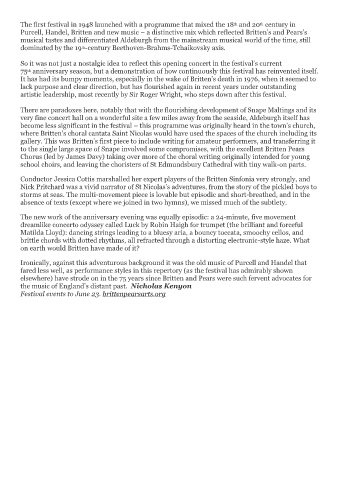Page 554 - Media Coverage Book - 75th Aldeburgh Festival 2024
P. 554
The first festival in 1948 launched with a programme that mixed the 18 and 20 century in
th
th
Purcell, Handel, Britten and new music – a distinctive mix which reflected Britten’s and Pears’s
musical tastes and differentiated Aldeburgh from the mainstream musical world of the time, still
dominated by the 19 -century Beethoven-Brahms-Tchaikovsky axis.
th
So it was not just a nostalgic idea to reflect this opening concert in the festival’s current
75 anniversary season, but a demonstration of how continuously this festival has reinvented itself.
th
It has had its bumpy moments, especially in the wake of Britten’s death in 1976, when it seemed to
lack purpose and clear direction, but has flourished again in recent years under outstanding
artistic leadership, most recently by Sir Roger Wright, who steps down after this festival.
There are paradoxes here, notably that with the flourishing development of Snape Maltings and its
very fine concert hall on a wonderful site a few miles away from the seaside, Aldeburgh itself has
become less significant in the festival – this programme was originally heard in the town’s church,
where Britten’s choral cantata Saint Nicolas would have used the spaces of the church including its
gallery. This was Britten’s first piece to include writing for amateur performers, and transferring it
to the single large space of Snape involved some compromises, with the excellent Britten Pears
Chorus (led by James Davy) taking over more of the choral writing originally intended for young
school choirs, and leaving the choristers of St Edmundsbury Cathedral with tiny walk-on parts.
Conductor Jessica Cottis marshalled her expert players of the Britten Sinfonia very strongly, and
Nick Pritchard was a vivid narrator of St Nicolas’s adventures, from the story of the pickled boys to
storms at seas. The multi-movement piece is lovable but episodic and short-breathed, and in the
absence of texts (except where we joined in two hymns), we missed much of the subtlety.
The new work of the anniversary evening was equally episodic: a 24-minute, five movement
dreamlike concerto odyssey called Luck by Robin Haigh for trumpet (the brilliant and forceful
Matilda Lloyd): dancing strings leading to a bluesy aria, a bouncy toccata, smoochy cellos, and
brittle chords with dotted rhythms, all refracted through a distorting electronic-style haze. What
on earth would Britten have made of it?
Ironically, against this adventurous background it was the old music of Purcell and Handel that
fared less well, as performance styles in this repertory (as the festival has admirably shown
elsewhere) have strode on in the 75 years since Britten and Pears were such fervent advocates for
the music of England’s distant past. Nicholas Kenyon
Festival events to June 23. brittenpearsarts.org

